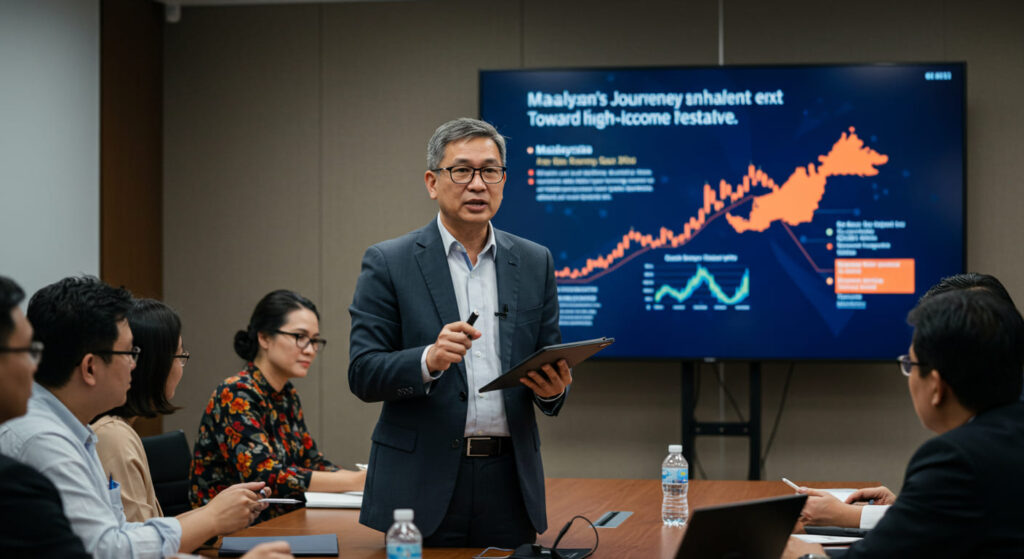Malaysia Journey to High-Income Status: Are We Truly on Track for 2028?
Malaysia has set an ambitious target to transition from a middle-income economy to a high-income status by 2028. The stakes are high, and the implications are profound for Malaysians. With economic transformation and strategic planning underway, the big question remains: Can Malaysia meet the World Bank’s high-income threshold within the next five years?
To achieve high-income status, Malaysia needs to overcome key challenges and seize opportunities that will drive sustainable economic growth. Let’s explore the critical factors shaping the nation’s journey towards high-income status by 2028.
What Does High-Income Status Mean?
The World Bank defines high-income economies as those with a gross national income (GNI) per capita exceeding $14,000. Malaysia’s GNI per capita stood at $12,200 in 2023, placing it within striking distance of achieving high-income status.
However, achieving this milestone is not just about numbers. High-income status reflects a broader economic transformation, one where sustainable growth, increased productivity, and improved quality of life for Malaysians are paramount.
Economic growth is a cornerstone of this transformation. Malaysia’s GDP growth in 2024 was strong at 5.3%, signaling positive momentum. However, for Malaysia to maintain its trajectory and reach high-income status by 2028, robust growth must be complemented by key structural reforms.
The Role of GDP, GNI, and Per Capita Income in Economic Growth
Malaysia’s economic growth hinges on both gross domestic product (GDP) and GNI. While GDP measures the total output of the economy, GNI includes income earned by Malaysians abroad and subtracts income earned by foreigners within Malaysia.
In 2023, Malaysia managed to achieve steady growth in GNI despite challenges such as financial outflows. These outflows, a reflection of income sent abroad, slightly dampen the impact of GDP growth on per capita income. Yet, Malaysia’s economy has shown resilience, positioning itself on track to reach high-income status by 2028.
Why Currency Strength Matters for Malaysia’s Economy
A vital factor influencing GNI is the strength of the Malaysian ringgit. Since GNI per capita is calculated in US dollars, the ringgit’s exchange rate directly impacts Malaysia’s ability to achieve the high-income level.
In 2023, the ringgit averaged 4.59 against the US dollar, contributing to a GNI per capita of $11,970. If the ringgit had maintained its 2020 average of 4.02, Malaysia’s GNI could have been $13,680—bringing it closer to high-income status.
In 2024, the ringgit briefly strengthened to 4.1 but later stabilized around 4.4. For Malaysia to transition to a high-income economy, a consistently strong ringgit is crucial. The Malaysian government’s focus on fiscal and monetary discipline will play a key role in maintaining currency stability and boosting economic growth.
Structural Reforms and Economic Transformation
Malaysia’s journey to high-income status requires more than economic growth—it demands structural reforms that drive economic transformation.
One bold reform was the removal of diesel subsidies in 2024, saving the government RM4 billion annually. These funds could be channeled toward infrastructure projects like the MRT3, which is crucial for improving productivity and connectivity. Better public transport reduces commute times, enhances efficiency, and attracts foreign investment—all of which contribute to Malaysia’s economic transformation.
By redirecting resources from subsidies to infrastructure, Malaysia is building a foundation for long-term growth. This approach ensures sustainable growth while addressing key challenges like fiscal stability and resource allocation.
Foreign Direct Investment: Key to Economic Growth
Foreign direct investment (FDI) is pivotal for Malaysia’s economy. In the first half of 2024, Malaysia attracted RM160 billion in FDI, an 18% increase from the previous year. This investment is expected to create over 33,000 high-value jobs, boosting per capita income and driving Malaysia towards high-income status.
The National Semiconductor Strategy (NSS) is a flagship initiative that highlights Malaysia’s focus on economic transformation. As the world’s sixth-largest semiconductor exporter, Malaysia is already a key player in the global value chain. However, most of its activities are concentrated on assembly and testing.
The NSS aims to elevate Malaysia’s role by promoting innovation, research, and advanced manufacturing. This shift will help Malaysia move up the value chain, creating higher-value jobs and increasing productivity.
Challenges on the Road to High-Income Status
While Malaysia is making progress, challenges like an aging population and external uncertainties could slow its momentum.
By 2030, Malaysia is expected to become an aging nation, with a significant portion of its population over 60. This demographic shift poses economic risks, as a smaller workforce could increase labor costs and reduce overall productivity.

Moreover, global factors like geopolitical tensions and climate change impact Malaysia’s economy. Trade disruptions and supply chain shifts can affect exports, while climate-related events may threaten infrastructure and agriculture.
Despite these hurdles, Malaysia is navigating opportunities. Businesses diversifying away from China due to trade conflicts may turn to Malaysia as an alternative hub. Additionally, Malaysia’s involvement in BRICS provides access to new markets and technological exchange, supporting its economic transformation.
Malaysia’s Economic Outlook: 2024 and Beyond
Malaysia’s economic outlook for 2024 and 2028 remains promising, with GDP growth projected at 4.5% to 5.5% in 2025. Strong policies, strategic investments, and structural reforms are positioning Malaysia to achieve its high-income aspirations.
Economic transformation initiatives, such as the NSS and infrastructure development, create opportunities for sustainable growth. These efforts ensure that Malaysia’s progress benefits all Malaysians, boosting productivity and quality of life.
The Path Forward for Malaysia’s Economy
Malaysia is on track to reach high-income status by 2028, but achieving this goal requires continued focus on sustainable growth and innovation.
Key strategies include attracting high-value FDI, promoting skill development, and fostering fiscal stability. By addressing challenges like currency fluctuations and demographic shifts, Malaysia can ensure a smooth transition to high-income status.
As Malaysia’s chief economist suggests, the nation’s journey to high-income status reflects its commitment to long-term growth and resilience. With the right policies and investments, Malaysia could become a high-income economy by the end of the decade.

Conclusion: Malaysia Journey to High-Income Status, Are We Truly on Track for 2028?
Malaysia’s transition to high-income status is both an economic and societal milestone. While challenges like the middle-income trap and global uncertainties remain, Malaysia’s economy has demonstrated remarkable resilience and adaptability.
With strategic reforms, sustainable policies, and economic transformation, Malaysia is likely to reach the high-income level that it aspires to. As we move closer to 2028, the journey highlights Malaysia’s potential to become a high-income economy that benefits all its citizens.




